NURBN3022 - Sample HREC Application: Homeless Health in Australia
VerifiedAdded on 2022/11/04
|14
|4090
|301
Project
AI Summary
This document presents a sample Human Research Ethics Committee (HREC) application for a research project focused on the health crisis faced by homeless individuals in Australia, specifically examining the impact of homelessness on the mental health of women. The application details the project's title, research team, and a comprehensive lay description of the study's aims, which include understanding the causes of homelessness, its impact on health, and factors influencing the mental health of homeless women. The research aims to recommend measures to improve the psychiatric condition of this vulnerable population. The application outlines the research methodology, including the interpretive research philosophy, inductive approach, probabilistic sampling of 50 homeless women, and data collection through survey questionnaires and secondary data analysis. It also describes the data analysis techniques, including thematic analysis, and the recruitment strategy, emphasizing random sampling. The project's significance is highlighted by referencing existing literature on homelessness, domestic violence, mental health, and the unique challenges faced by homeless women. The application aims to contribute to the understanding of homelessness and improve mental health outcomes for the target population.
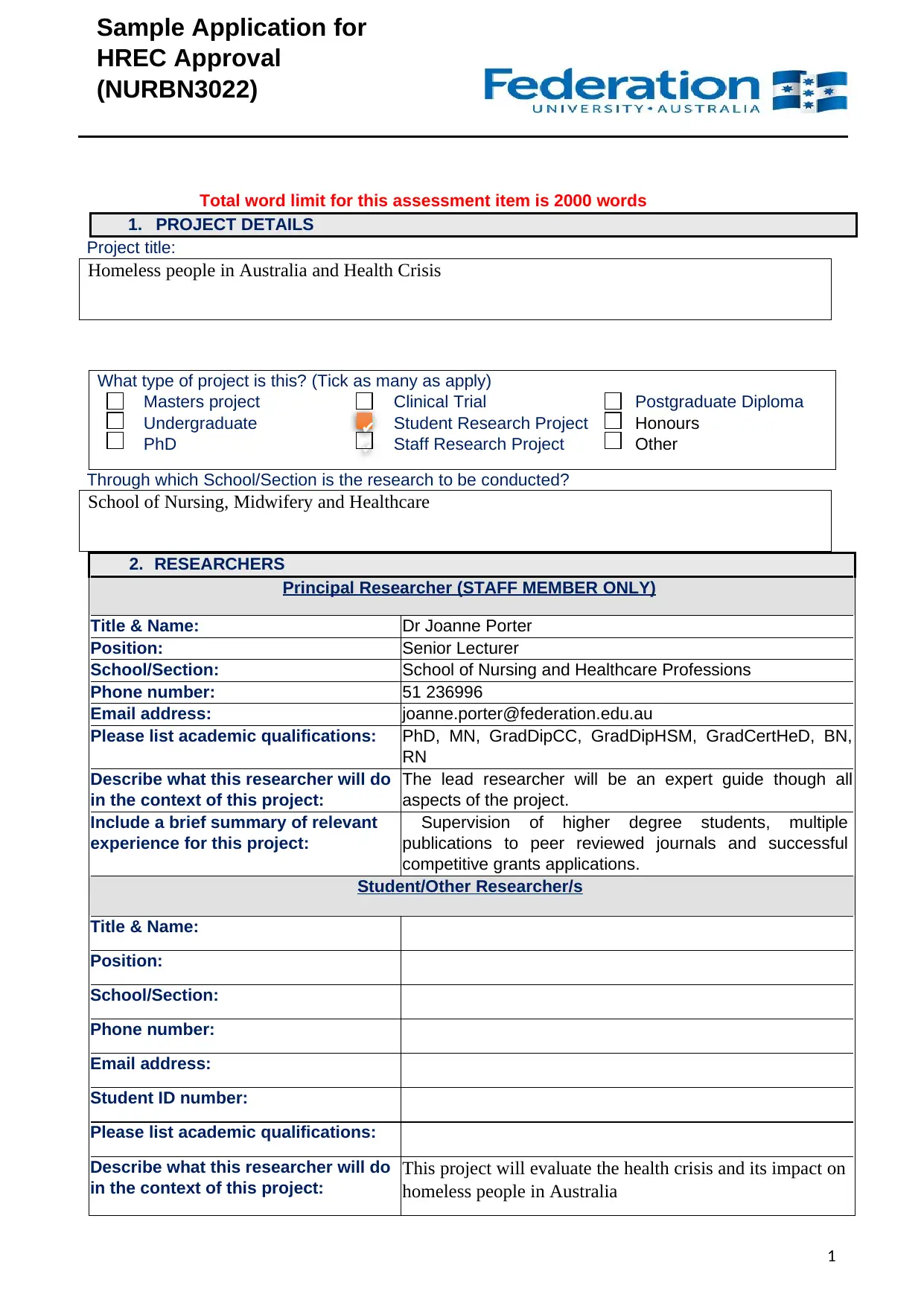
Sample Application for
HREC Approval
(NURBN3022)
Total word limit for this assessment item is 2000 words
1. PROJECT DETAILS
Project title:
Homeless people in Australia and Health Crisis
What type of project is this? (Tick as many as apply)
Masters project Clinical Trial Postgraduate Diploma
Undergraduate Student Research Project Honours
PhD Staff Research Project Other
Through which School/Section is the research to be conducted?
School of Nursing, Midwifery and Healthcare
2. RESEARCHERS
Principal Researcher (STAFF MEMBER ONLY)
Title & Name: Dr Joanne Porter
Position: Senior Lecturer
School/Section: School of Nursing and Healthcare Professions
Phone number: 51 236996
Email address: joanne.porter@federation.edu.au
Please list academic qualifications: PhD, MN, GradDipCC, GradDipHSM, GradCertHeD, BN,
RN
Describe what this researcher will do
in the context of this project:
The lead researcher will be an expert guide though all
aspects of the project.
Include a brief summary of relevant
experience for this project:
Supervision of higher degree students, multiple
publications to peer reviewed journals and successful
competitive grants applications.
Student/Other Researcher/s
Title & Name:
Position:
School/Section:
Phone number:
Email address:
Student ID number:
Please list academic qualifications:
Describe what this researcher will do
in the context of this project:
This project will evaluate the health crisis and its impact on
homeless people in Australia
1
✔
✔
HREC Approval
(NURBN3022)
Total word limit for this assessment item is 2000 words
1. PROJECT DETAILS
Project title:
Homeless people in Australia and Health Crisis
What type of project is this? (Tick as many as apply)
Masters project Clinical Trial Postgraduate Diploma
Undergraduate Student Research Project Honours
PhD Staff Research Project Other
Through which School/Section is the research to be conducted?
School of Nursing, Midwifery and Healthcare
2. RESEARCHERS
Principal Researcher (STAFF MEMBER ONLY)
Title & Name: Dr Joanne Porter
Position: Senior Lecturer
School/Section: School of Nursing and Healthcare Professions
Phone number: 51 236996
Email address: joanne.porter@federation.edu.au
Please list academic qualifications: PhD, MN, GradDipCC, GradDipHSM, GradCertHeD, BN,
RN
Describe what this researcher will do
in the context of this project:
The lead researcher will be an expert guide though all
aspects of the project.
Include a brief summary of relevant
experience for this project:
Supervision of higher degree students, multiple
publications to peer reviewed journals and successful
competitive grants applications.
Student/Other Researcher/s
Title & Name:
Position:
School/Section:
Phone number:
Email address:
Student ID number:
Please list academic qualifications:
Describe what this researcher will do
in the context of this project:
This project will evaluate the health crisis and its impact on
homeless people in Australia
1
✔
✔
Paraphrase This Document
Need a fresh take? Get an instant paraphrase of this document with our AI Paraphraser
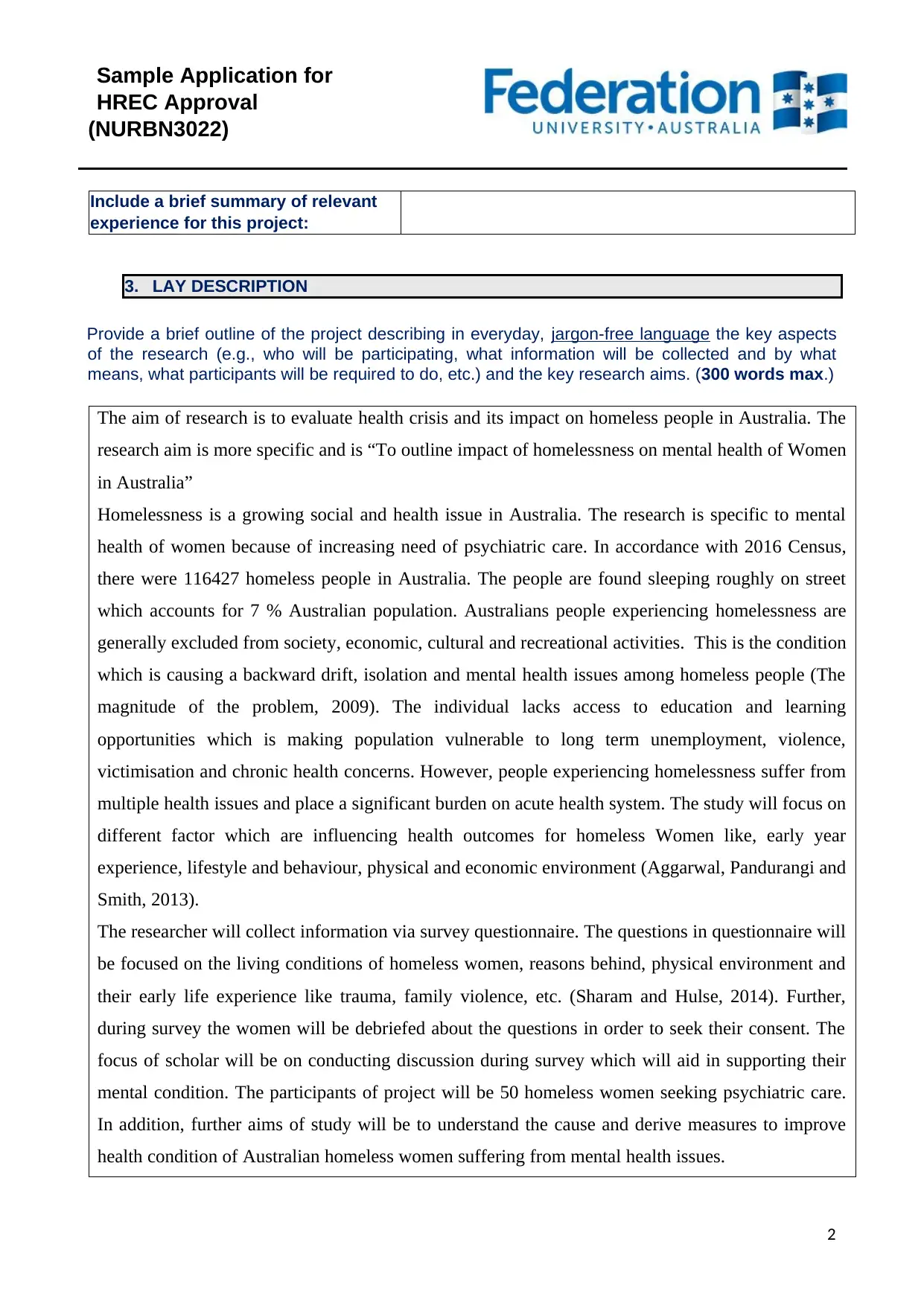
Sample Application for
HREC Approval
(NURBN3022)
Include a brief summary of relevant
experience for this project:
3. LAY DESCRIPTION
Provide a brief outline of the project describing in everyday, jargon-free language the key aspects
of the research (e.g., who will be participating, what information will be collected and by what
means, what participants will be required to do, etc.) and the key research aims. (300 words max.)
The aim of research is to evaluate health crisis and its impact on homeless people in Australia. The
research aim is more specific and is “To outline impact of homelessness on mental health of Women
in Australia”
Homelessness is a growing social and health issue in Australia. The research is specific to mental
health of women because of increasing need of psychiatric care. In accordance with 2016 Census,
there were 116427 homeless people in Australia. The people are found sleeping roughly on street
which accounts for 7 % Australian population. Australians people experiencing homelessness are
generally excluded from society, economic, cultural and recreational activities. This is the condition
which is causing a backward drift, isolation and mental health issues among homeless people (The
magnitude of the problem, 2009). The individual lacks access to education and learning
opportunities which is making population vulnerable to long term unemployment, violence,
victimisation and chronic health concerns. However, people experiencing homelessness suffer from
multiple health issues and place a significant burden on acute health system. The study will focus on
different factor which are influencing health outcomes for homeless Women like, early year
experience, lifestyle and behaviour, physical and economic environment (Aggarwal, Pandurangi and
Smith, 2013).
The researcher will collect information via survey questionnaire. The questions in questionnaire will
be focused on the living conditions of homeless women, reasons behind, physical environment and
their early life experience like trauma, family violence, etc. (Sharam and Hulse, 2014). Further,
during survey the women will be debriefed about the questions in order to seek their consent. The
focus of scholar will be on conducting discussion during survey which will aid in supporting their
mental condition. The participants of project will be 50 homeless women seeking psychiatric care.
In addition, further aims of study will be to understand the cause and derive measures to improve
health condition of Australian homeless women suffering from mental health issues.
2
HREC Approval
(NURBN3022)
Include a brief summary of relevant
experience for this project:
3. LAY DESCRIPTION
Provide a brief outline of the project describing in everyday, jargon-free language the key aspects
of the research (e.g., who will be participating, what information will be collected and by what
means, what participants will be required to do, etc.) and the key research aims. (300 words max.)
The aim of research is to evaluate health crisis and its impact on homeless people in Australia. The
research aim is more specific and is “To outline impact of homelessness on mental health of Women
in Australia”
Homelessness is a growing social and health issue in Australia. The research is specific to mental
health of women because of increasing need of psychiatric care. In accordance with 2016 Census,
there were 116427 homeless people in Australia. The people are found sleeping roughly on street
which accounts for 7 % Australian population. Australians people experiencing homelessness are
generally excluded from society, economic, cultural and recreational activities. This is the condition
which is causing a backward drift, isolation and mental health issues among homeless people (The
magnitude of the problem, 2009). The individual lacks access to education and learning
opportunities which is making population vulnerable to long term unemployment, violence,
victimisation and chronic health concerns. However, people experiencing homelessness suffer from
multiple health issues and place a significant burden on acute health system. The study will focus on
different factor which are influencing health outcomes for homeless Women like, early year
experience, lifestyle and behaviour, physical and economic environment (Aggarwal, Pandurangi and
Smith, 2013).
The researcher will collect information via survey questionnaire. The questions in questionnaire will
be focused on the living conditions of homeless women, reasons behind, physical environment and
their early life experience like trauma, family violence, etc. (Sharam and Hulse, 2014). Further,
during survey the women will be debriefed about the questions in order to seek their consent. The
focus of scholar will be on conducting discussion during survey which will aid in supporting their
mental condition. The participants of project will be 50 homeless women seeking psychiatric care.
In addition, further aims of study will be to understand the cause and derive measures to improve
health condition of Australian homeless women suffering from mental health issues.
2
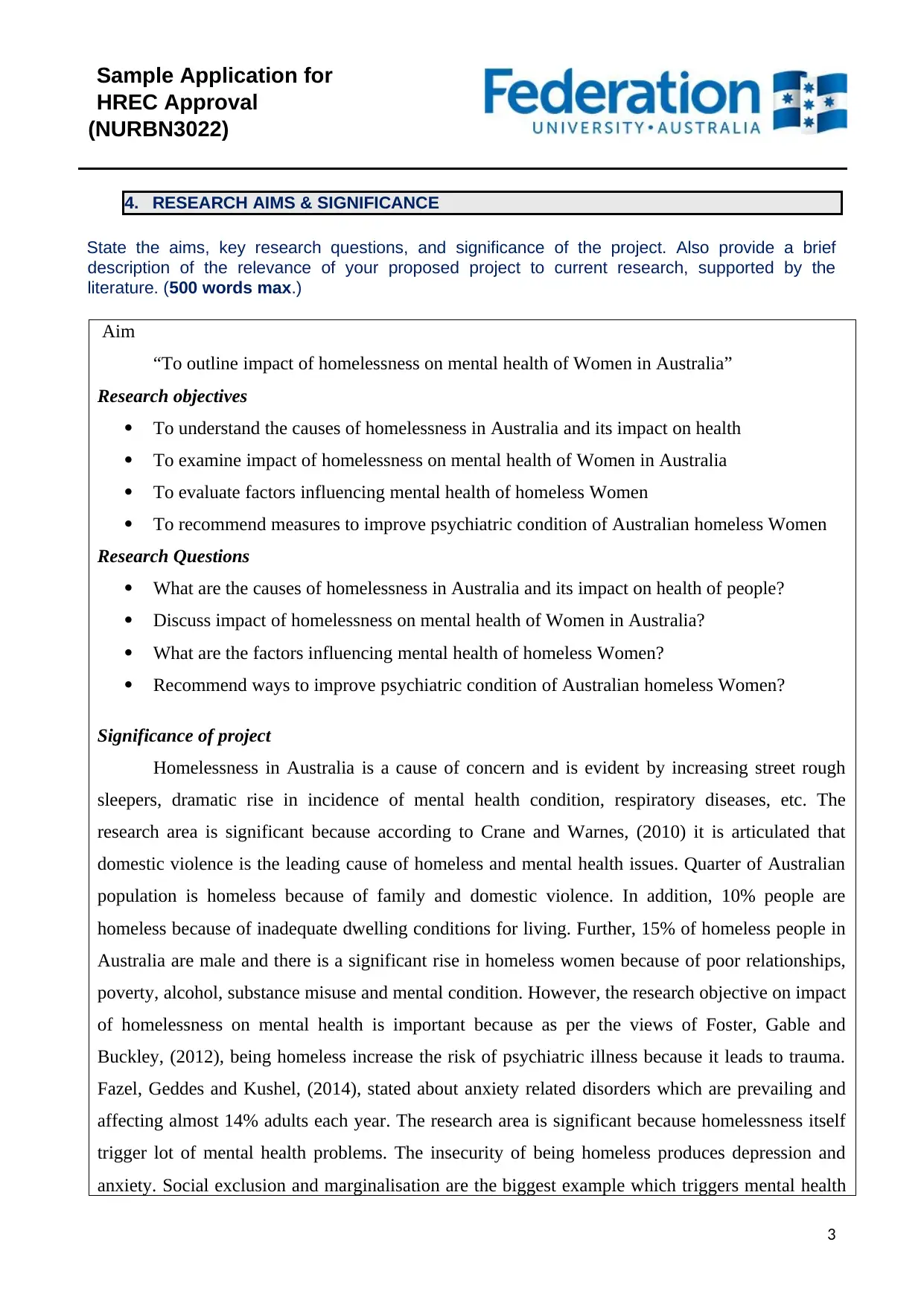
Sample Application for
HREC Approval
(NURBN3022)
4. RESEARCH AIMS & SIGNIFICANCE
State the aims, key research questions, and significance of the project. Also provide a brief
description of the relevance of your proposed project to current research, supported by the
literature. (500 words max.)
Aim
“To outline impact of homelessness on mental health of Women in Australia”
Research objectives
To understand the causes of homelessness in Australia and its impact on health
To examine impact of homelessness on mental health of Women in Australia
To evaluate factors influencing mental health of homeless Women
To recommend measures to improve psychiatric condition of Australian homeless Women
Research Questions
What are the causes of homelessness in Australia and its impact on health of people?
Discuss impact of homelessness on mental health of Women in Australia?
What are the factors influencing mental health of homeless Women?
Recommend ways to improve psychiatric condition of Australian homeless Women?
Significance of project
Homelessness in Australia is a cause of concern and is evident by increasing street rough
sleepers, dramatic rise in incidence of mental health condition, respiratory diseases, etc. The
research area is significant because according to Crane and Warnes, (2010) it is articulated that
domestic violence is the leading cause of homeless and mental health issues. Quarter of Australian
population is homeless because of family and domestic violence. In addition, 10% people are
homeless because of inadequate dwelling conditions for living. Further, 15% of homeless people in
Australia are male and there is a significant rise in homeless women because of poor relationships,
poverty, alcohol, substance misuse and mental condition. However, the research objective on impact
of homelessness on mental health is important because as per the views of Foster, Gable and
Buckley, (2012), being homeless increase the risk of psychiatric illness because it leads to trauma.
Fazel, Geddes and Kushel, (2014), stated about anxiety related disorders which are prevailing and
affecting almost 14% adults each year. The research area is significant because homelessness itself
trigger lot of mental health problems. The insecurity of being homeless produces depression and
anxiety. Social exclusion and marginalisation are the biggest example which triggers mental health
3
HREC Approval
(NURBN3022)
4. RESEARCH AIMS & SIGNIFICANCE
State the aims, key research questions, and significance of the project. Also provide a brief
description of the relevance of your proposed project to current research, supported by the
literature. (500 words max.)
Aim
“To outline impact of homelessness on mental health of Women in Australia”
Research objectives
To understand the causes of homelessness in Australia and its impact on health
To examine impact of homelessness on mental health of Women in Australia
To evaluate factors influencing mental health of homeless Women
To recommend measures to improve psychiatric condition of Australian homeless Women
Research Questions
What are the causes of homelessness in Australia and its impact on health of people?
Discuss impact of homelessness on mental health of Women in Australia?
What are the factors influencing mental health of homeless Women?
Recommend ways to improve psychiatric condition of Australian homeless Women?
Significance of project
Homelessness in Australia is a cause of concern and is evident by increasing street rough
sleepers, dramatic rise in incidence of mental health condition, respiratory diseases, etc. The
research area is significant because according to Crane and Warnes, (2010) it is articulated that
domestic violence is the leading cause of homeless and mental health issues. Quarter of Australian
population is homeless because of family and domestic violence. In addition, 10% people are
homeless because of inadequate dwelling conditions for living. Further, 15% of homeless people in
Australia are male and there is a significant rise in homeless women because of poor relationships,
poverty, alcohol, substance misuse and mental condition. However, the research objective on impact
of homelessness on mental health is important because as per the views of Foster, Gable and
Buckley, (2012), being homeless increase the risk of psychiatric illness because it leads to trauma.
Fazel, Geddes and Kushel, (2014), stated about anxiety related disorders which are prevailing and
affecting almost 14% adults each year. The research area is significant because homelessness itself
trigger lot of mental health problems. The insecurity of being homeless produces depression and
anxiety. Social exclusion and marginalisation are the biggest example which triggers mental health
3
⊘ This is a preview!⊘
Do you want full access?
Subscribe today to unlock all pages.

Trusted by 1+ million students worldwide
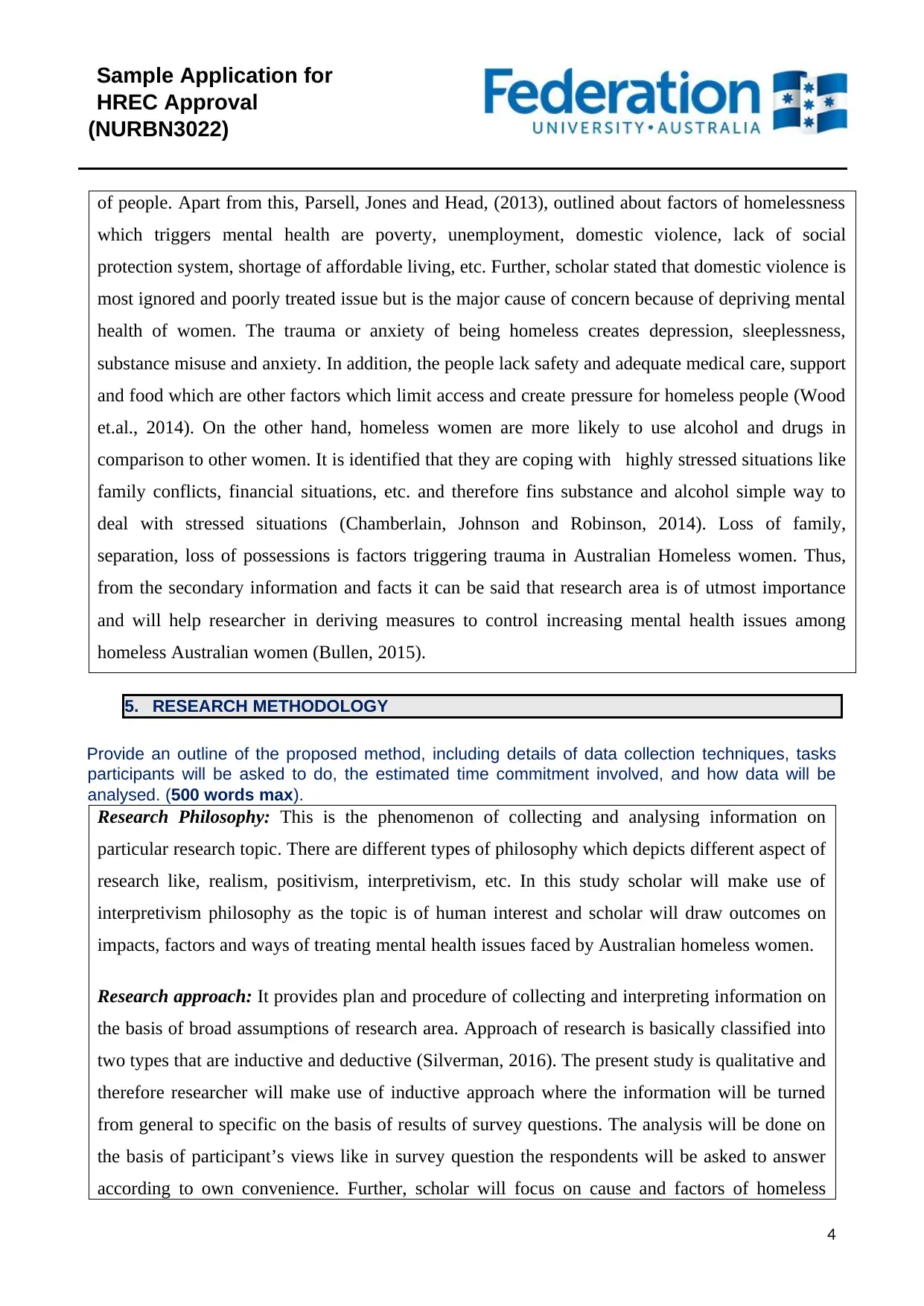
Sample Application for
HREC Approval
(NURBN3022)
of people. Apart from this, Parsell, Jones and Head, (2013), outlined about factors of homelessness
which triggers mental health are poverty, unemployment, domestic violence, lack of social
protection system, shortage of affordable living, etc. Further, scholar stated that domestic violence is
most ignored and poorly treated issue but is the major cause of concern because of depriving mental
health of women. The trauma or anxiety of being homeless creates depression, sleeplessness,
substance misuse and anxiety. In addition, the people lack safety and adequate medical care, support
and food which are other factors which limit access and create pressure for homeless people (Wood
et.al., 2014). On the other hand, homeless women are more likely to use alcohol and drugs in
comparison to other women. It is identified that they are coping with highly stressed situations like
family conflicts, financial situations, etc. and therefore fins substance and alcohol simple way to
deal with stressed situations (Chamberlain, Johnson and Robinson, 2014). Loss of family,
separation, loss of possessions is factors triggering trauma in Australian Homeless women. Thus,
from the secondary information and facts it can be said that research area is of utmost importance
and will help researcher in deriving measures to control increasing mental health issues among
homeless Australian women (Bullen, 2015).
5. RESEARCH METHODOLOGY
Provide an outline of the proposed method, including details of data collection techniques, tasks
participants will be asked to do, the estimated time commitment involved, and how data will be
analysed. (500 words max).
Research Philosophy: This is the phenomenon of collecting and analysing information on
particular research topic. There are different types of philosophy which depicts different aspect of
research like, realism, positivism, interpretivism, etc. In this study scholar will make use of
interpretivism philosophy as the topic is of human interest and scholar will draw outcomes on
impacts, factors and ways of treating mental health issues faced by Australian homeless women.
Research approach: It provides plan and procedure of collecting and interpreting information on
the basis of broad assumptions of research area. Approach of research is basically classified into
two types that are inductive and deductive (Silverman, 2016). The present study is qualitative and
therefore researcher will make use of inductive approach where the information will be turned
from general to specific on the basis of results of survey questions. The analysis will be done on
the basis of participant’s views like in survey question the respondents will be asked to answer
according to own convenience. Further, scholar will focus on cause and factors of homeless
4
HREC Approval
(NURBN3022)
of people. Apart from this, Parsell, Jones and Head, (2013), outlined about factors of homelessness
which triggers mental health are poverty, unemployment, domestic violence, lack of social
protection system, shortage of affordable living, etc. Further, scholar stated that domestic violence is
most ignored and poorly treated issue but is the major cause of concern because of depriving mental
health of women. The trauma or anxiety of being homeless creates depression, sleeplessness,
substance misuse and anxiety. In addition, the people lack safety and adequate medical care, support
and food which are other factors which limit access and create pressure for homeless people (Wood
et.al., 2014). On the other hand, homeless women are more likely to use alcohol and drugs in
comparison to other women. It is identified that they are coping with highly stressed situations like
family conflicts, financial situations, etc. and therefore fins substance and alcohol simple way to
deal with stressed situations (Chamberlain, Johnson and Robinson, 2014). Loss of family,
separation, loss of possessions is factors triggering trauma in Australian Homeless women. Thus,
from the secondary information and facts it can be said that research area is of utmost importance
and will help researcher in deriving measures to control increasing mental health issues among
homeless Australian women (Bullen, 2015).
5. RESEARCH METHODOLOGY
Provide an outline of the proposed method, including details of data collection techniques, tasks
participants will be asked to do, the estimated time commitment involved, and how data will be
analysed. (500 words max).
Research Philosophy: This is the phenomenon of collecting and analysing information on
particular research topic. There are different types of philosophy which depicts different aspect of
research like, realism, positivism, interpretivism, etc. In this study scholar will make use of
interpretivism philosophy as the topic is of human interest and scholar will draw outcomes on
impacts, factors and ways of treating mental health issues faced by Australian homeless women.
Research approach: It provides plan and procedure of collecting and interpreting information on
the basis of broad assumptions of research area. Approach of research is basically classified into
two types that are inductive and deductive (Silverman, 2016). The present study is qualitative and
therefore researcher will make use of inductive approach where the information will be turned
from general to specific on the basis of results of survey questions. The analysis will be done on
the basis of participant’s views like in survey question the respondents will be asked to answer
according to own convenience. Further, scholar will focus on cause and factors of homeless
4
Paraphrase This Document
Need a fresh take? Get an instant paraphrase of this document with our AI Paraphraser
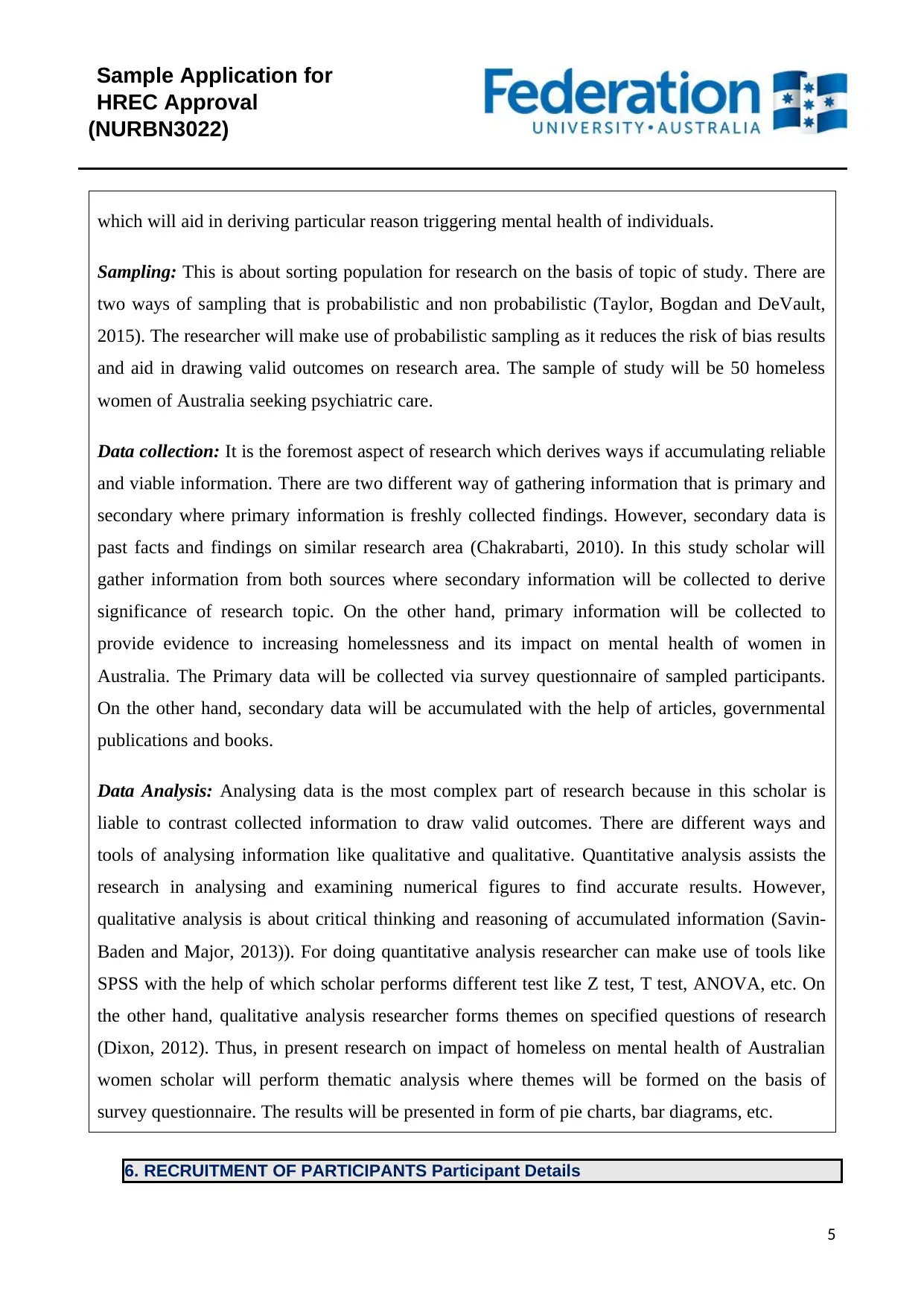
Sample Application for
HREC Approval
(NURBN3022)
which will aid in deriving particular reason triggering mental health of individuals.
Sampling: This is about sorting population for research on the basis of topic of study. There are
two ways of sampling that is probabilistic and non probabilistic (Taylor, Bogdan and DeVault,
2015). The researcher will make use of probabilistic sampling as it reduces the risk of bias results
and aid in drawing valid outcomes on research area. The sample of study will be 50 homeless
women of Australia seeking psychiatric care.
Data collection: It is the foremost aspect of research which derives ways if accumulating reliable
and viable information. There are two different way of gathering information that is primary and
secondary where primary information is freshly collected findings. However, secondary data is
past facts and findings on similar research area (Chakrabarti, 2010). In this study scholar will
gather information from both sources where secondary information will be collected to derive
significance of research topic. On the other hand, primary information will be collected to
provide evidence to increasing homelessness and its impact on mental health of women in
Australia. The Primary data will be collected via survey questionnaire of sampled participants.
On the other hand, secondary data will be accumulated with the help of articles, governmental
publications and books.
Data Analysis: Analysing data is the most complex part of research because in this scholar is
liable to contrast collected information to draw valid outcomes. There are different ways and
tools of analysing information like qualitative and qualitative. Quantitative analysis assists the
research in analysing and examining numerical figures to find accurate results. However,
qualitative analysis is about critical thinking and reasoning of accumulated information (Savin-
Baden and Major, 2013)). For doing quantitative analysis researcher can make use of tools like
SPSS with the help of which scholar performs different test like Z test, T test, ANOVA, etc. On
the other hand, qualitative analysis researcher forms themes on specified questions of research
(Dixon, 2012). Thus, in present research on impact of homeless on mental health of Australian
women scholar will perform thematic analysis where themes will be formed on the basis of
survey questionnaire. The results will be presented in form of pie charts, bar diagrams, etc.
6. RECRUITMENT OF PARTICIPANTS Participant Details
5
HREC Approval
(NURBN3022)
which will aid in deriving particular reason triggering mental health of individuals.
Sampling: This is about sorting population for research on the basis of topic of study. There are
two ways of sampling that is probabilistic and non probabilistic (Taylor, Bogdan and DeVault,
2015). The researcher will make use of probabilistic sampling as it reduces the risk of bias results
and aid in drawing valid outcomes on research area. The sample of study will be 50 homeless
women of Australia seeking psychiatric care.
Data collection: It is the foremost aspect of research which derives ways if accumulating reliable
and viable information. There are two different way of gathering information that is primary and
secondary where primary information is freshly collected findings. However, secondary data is
past facts and findings on similar research area (Chakrabarti, 2010). In this study scholar will
gather information from both sources where secondary information will be collected to derive
significance of research topic. On the other hand, primary information will be collected to
provide evidence to increasing homelessness and its impact on mental health of women in
Australia. The Primary data will be collected via survey questionnaire of sampled participants.
On the other hand, secondary data will be accumulated with the help of articles, governmental
publications and books.
Data Analysis: Analysing data is the most complex part of research because in this scholar is
liable to contrast collected information to draw valid outcomes. There are different ways and
tools of analysing information like qualitative and qualitative. Quantitative analysis assists the
research in analysing and examining numerical figures to find accurate results. However,
qualitative analysis is about critical thinking and reasoning of accumulated information (Savin-
Baden and Major, 2013)). For doing quantitative analysis researcher can make use of tools like
SPSS with the help of which scholar performs different test like Z test, T test, ANOVA, etc. On
the other hand, qualitative analysis researcher forms themes on specified questions of research
(Dixon, 2012). Thus, in present research on impact of homeless on mental health of Australian
women scholar will perform thematic analysis where themes will be formed on the basis of
survey questionnaire. The results will be presented in form of pie charts, bar diagrams, etc.
6. RECRUITMENT OF PARTICIPANTS Participant Details
5
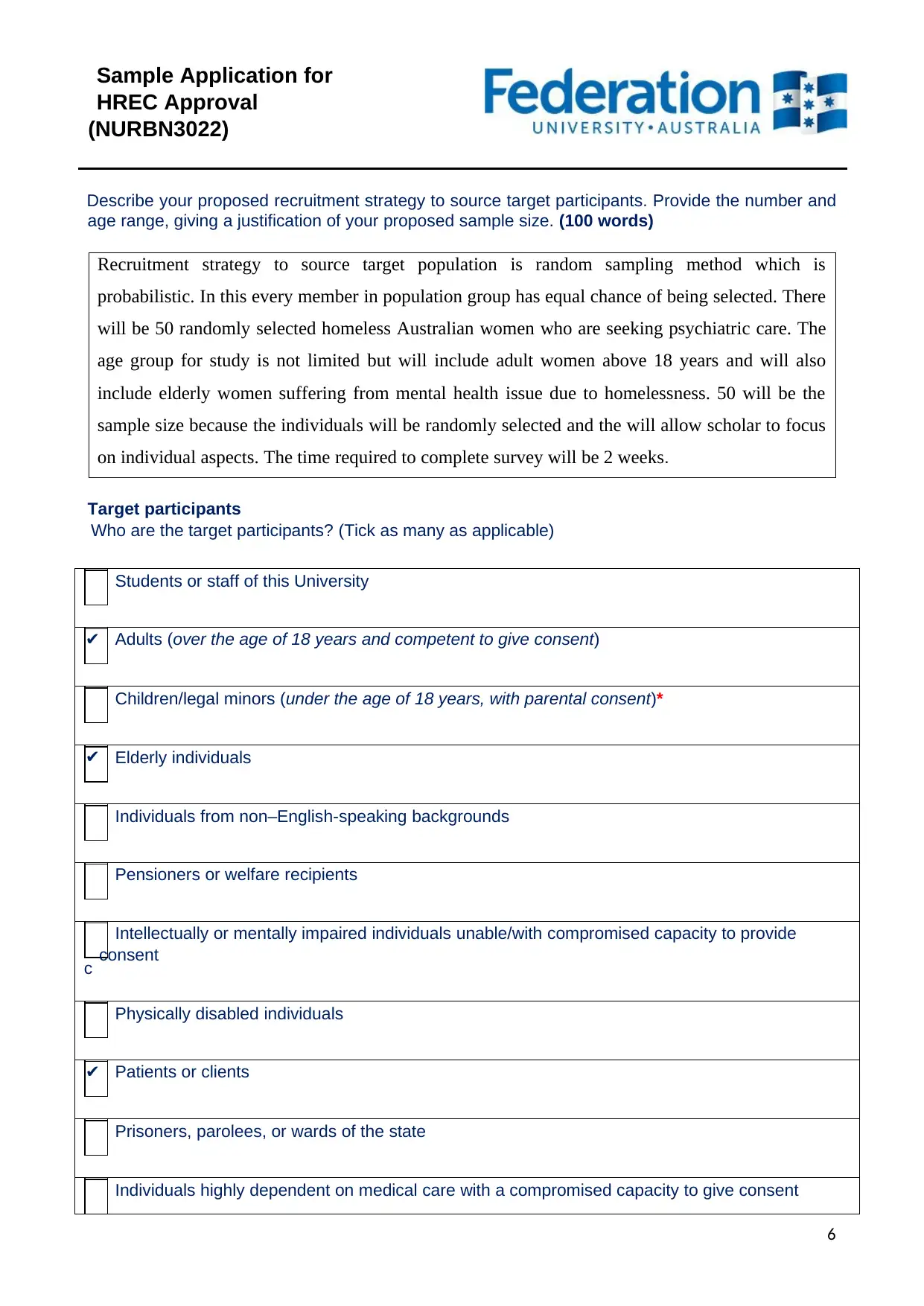
Sample Application for
HREC Approval
(NURBN3022)
Describe your proposed recruitment strategy to source target participants. Provide the number and
age range, giving a justification of your proposed sample size. (100 words)
Recruitment strategy to source target population is random sampling method which is
probabilistic. In this every member in population group has equal chance of being selected. There
will be 50 randomly selected homeless Australian women who are seeking psychiatric care. The
age group for study is not limited but will include adult women above 18 years and will also
include elderly women suffering from mental health issue due to homelessness. 50 will be the
sample size because the individuals will be randomly selected and the will allow scholar to focus
on individual aspects. The time required to complete survey will be 2 weeks.
Target participants
Who are the target participants? (Tick as many as applicable)
Students or staff of this University
✔ Adults (over the age of 18 years and competent to give consent)
Children/legal minors (under the age of 18 years, with parental consent)*
✔ Elderly individuals
Individuals from non–English-speaking backgrounds
Pensioners or welfare recipients
Intellectually or mentally impaired individuals unable/with compromised capacity to provide
consent
c
Physically disabled individuals
✔ Patients or clients
Prisoners, parolees, or wards of the state
Individuals highly dependent on medical care with a compromised capacity to give consent
6
HREC Approval
(NURBN3022)
Describe your proposed recruitment strategy to source target participants. Provide the number and
age range, giving a justification of your proposed sample size. (100 words)
Recruitment strategy to source target population is random sampling method which is
probabilistic. In this every member in population group has equal chance of being selected. There
will be 50 randomly selected homeless Australian women who are seeking psychiatric care. The
age group for study is not limited but will include adult women above 18 years and will also
include elderly women suffering from mental health issue due to homelessness. 50 will be the
sample size because the individuals will be randomly selected and the will allow scholar to focus
on individual aspects. The time required to complete survey will be 2 weeks.
Target participants
Who are the target participants? (Tick as many as applicable)
Students or staff of this University
✔ Adults (over the age of 18 years and competent to give consent)
Children/legal minors (under the age of 18 years, with parental consent)*
✔ Elderly individuals
Individuals from non–English-speaking backgrounds
Pensioners or welfare recipients
Intellectually or mentally impaired individuals unable/with compromised capacity to provide
consent
c
Physically disabled individuals
✔ Patients or clients
Prisoners, parolees, or wards of the state
Individuals highly dependent on medical care with a compromised capacity to give consent
6
⊘ This is a preview!⊘
Do you want full access?
Subscribe today to unlock all pages.

Trusted by 1+ million students worldwide
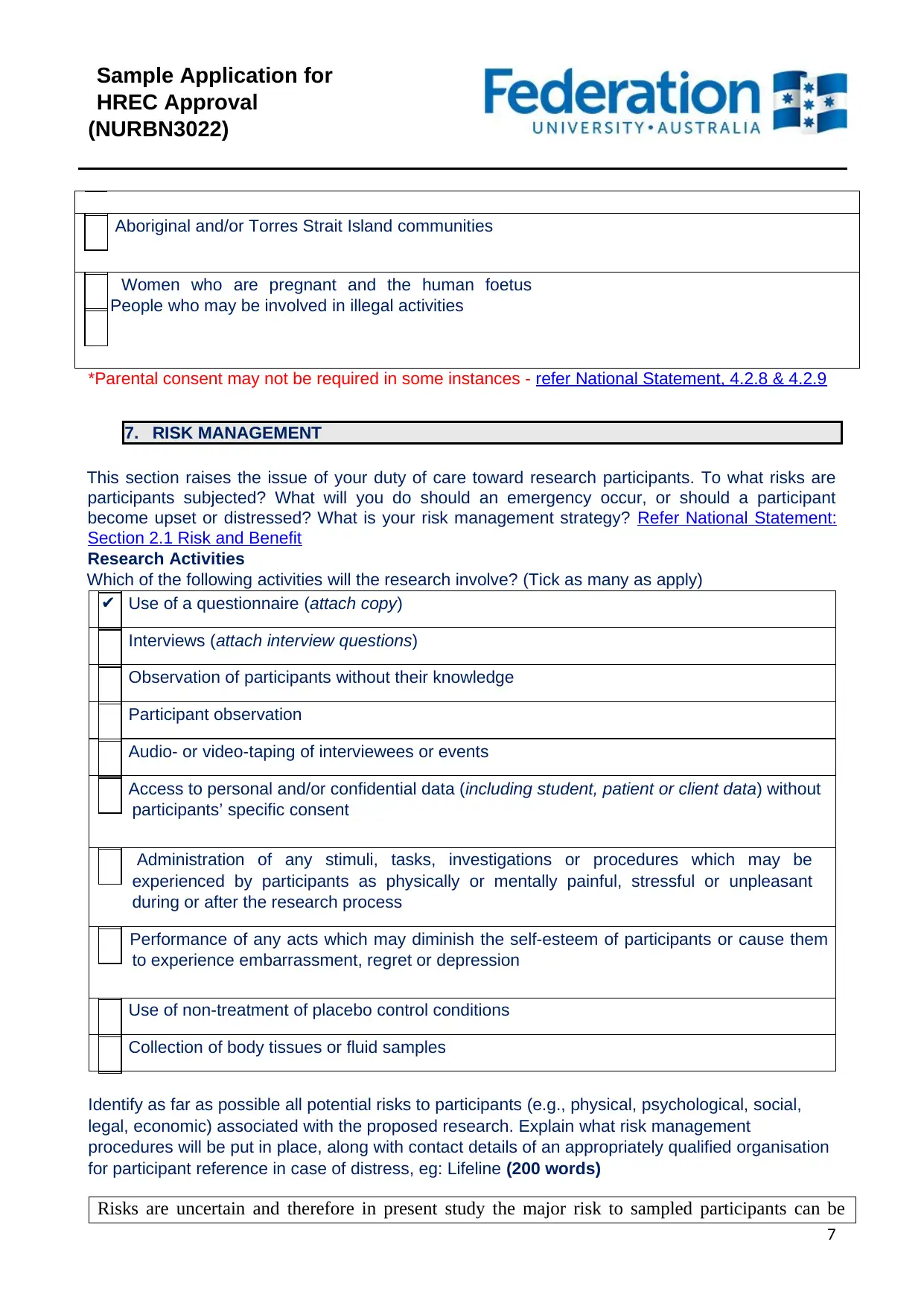
Sample Application for
HREC Approval
(NURBN3022)
Aboriginal and/or Torres Strait Island communities
Women who are pregnant and the human foetus
People who may be involved in illegal activities
*Parental consent may not be required in some instances - refer National Statement, 4.2.8 & 4.2.9
7. RISK MANAGEMENT
This section raises the issue of your duty of care toward research participants. To what risks are
participants subjected? What will you do should an emergency occur, or should a participant
become upset or distressed? What is your risk management strategy? Refer National Statement:
Section 2.1 Risk and Benefit
Research Activities
Which of the following activities will the research involve? (Tick as many as apply)
✔ Use of a questionnaire (attach copy)
Interviews (attach interview questions)
Observation of participants without their knowledge
Participant observation
Audio- or video-taping of interviewees or events
Access to personal and/or confidential data (including student, patient or client data) without
participants’ specific consent
Administration of any stimuli, tasks, investigations or procedures which may be
experienced by participants as physically or mentally painful, stressful or unpleasant
during or after the research process
Performance of any acts which may diminish the self-esteem of participants or cause them
to experience embarrassment, regret or depression
Use of non-treatment of placebo control conditions
Collection of body tissues or fluid samples
Identify as far as possible all potential risks to participants (e.g., physical, psychological, social,
legal, economic) associated with the proposed research. Explain what risk management
procedures will be put in place, along with contact details of an appropriately qualified organisation
for participant reference in case of distress, eg: Lifeline (200 words)
Risks are uncertain and therefore in present study the major risk to sampled participants can be
7
HREC Approval
(NURBN3022)
Aboriginal and/or Torres Strait Island communities
Women who are pregnant and the human foetus
People who may be involved in illegal activities
*Parental consent may not be required in some instances - refer National Statement, 4.2.8 & 4.2.9
7. RISK MANAGEMENT
This section raises the issue of your duty of care toward research participants. To what risks are
participants subjected? What will you do should an emergency occur, or should a participant
become upset or distressed? What is your risk management strategy? Refer National Statement:
Section 2.1 Risk and Benefit
Research Activities
Which of the following activities will the research involve? (Tick as many as apply)
✔ Use of a questionnaire (attach copy)
Interviews (attach interview questions)
Observation of participants without their knowledge
Participant observation
Audio- or video-taping of interviewees or events
Access to personal and/or confidential data (including student, patient or client data) without
participants’ specific consent
Administration of any stimuli, tasks, investigations or procedures which may be
experienced by participants as physically or mentally painful, stressful or unpleasant
during or after the research process
Performance of any acts which may diminish the self-esteem of participants or cause them
to experience embarrassment, regret or depression
Use of non-treatment of placebo control conditions
Collection of body tissues or fluid samples
Identify as far as possible all potential risks to participants (e.g., physical, psychological, social,
legal, economic) associated with the proposed research. Explain what risk management
procedures will be put in place, along with contact details of an appropriately qualified organisation
for participant reference in case of distress, eg: Lifeline (200 words)
Risks are uncertain and therefore in present study the major risk to sampled participants can be
7
Paraphrase This Document
Need a fresh take? Get an instant paraphrase of this document with our AI Paraphraser
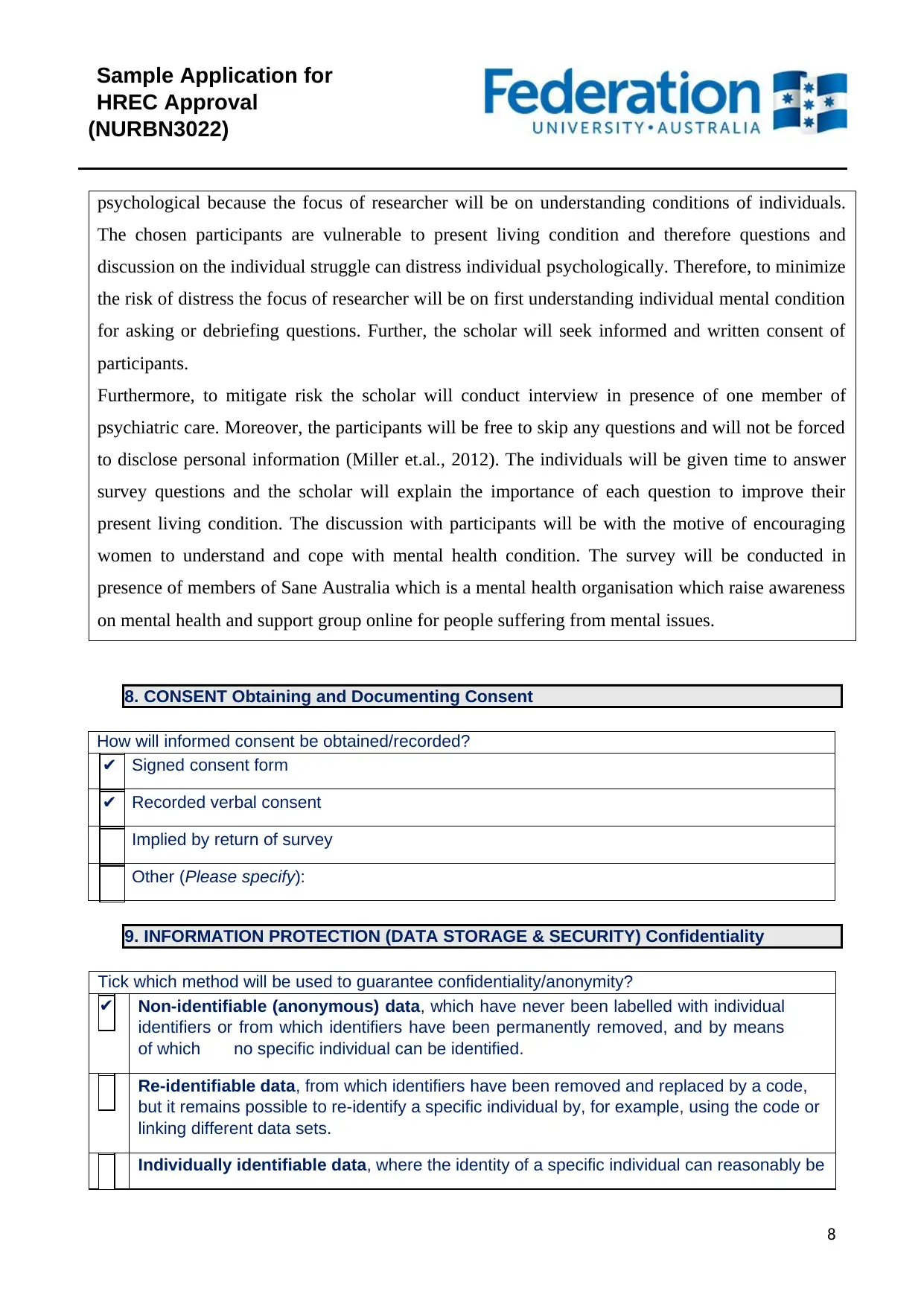
Sample Application for
HREC Approval
(NURBN3022)
psychological because the focus of researcher will be on understanding conditions of individuals.
The chosen participants are vulnerable to present living condition and therefore questions and
discussion on the individual struggle can distress individual psychologically. Therefore, to minimize
the risk of distress the focus of researcher will be on first understanding individual mental condition
for asking or debriefing questions. Further, the scholar will seek informed and written consent of
participants.
Furthermore, to mitigate risk the scholar will conduct interview in presence of one member of
psychiatric care. Moreover, the participants will be free to skip any questions and will not be forced
to disclose personal information (Miller et.al., 2012). The individuals will be given time to answer
survey questions and the scholar will explain the importance of each question to improve their
present living condition. The discussion with participants will be with the motive of encouraging
women to understand and cope with mental health condition. The survey will be conducted in
presence of members of Sane Australia which is a mental health organisation which raise awareness
on mental health and support group online for people suffering from mental issues.
8. CONSENT Obtaining and Documenting Consent
How will informed consent be obtained/recorded?
✔ Signed consent form
✔ Recorded verbal consent
Implied by return of survey
Other (Please specify):
9. INFORMATION PROTECTION (DATA STORAGE & SECURITY) Confidentiality
Tick which method will be used to guarantee confidentiality/anonymity?
✔ Non-identifiable (anonymous) data, which have never been labelled with individual
identifiers or from which identifiers have been permanently removed, and by means
of which no specific individual can be identified.
Re-identifiable data, from which identifiers have been removed and replaced by a code,
but it remains possible to re-identify a specific individual by, for example, using the code or
linking different data sets.
Individually identifiable data, where the identity of a specific individual can reasonably be
8
HREC Approval
(NURBN3022)
psychological because the focus of researcher will be on understanding conditions of individuals.
The chosen participants are vulnerable to present living condition and therefore questions and
discussion on the individual struggle can distress individual psychologically. Therefore, to minimize
the risk of distress the focus of researcher will be on first understanding individual mental condition
for asking or debriefing questions. Further, the scholar will seek informed and written consent of
participants.
Furthermore, to mitigate risk the scholar will conduct interview in presence of one member of
psychiatric care. Moreover, the participants will be free to skip any questions and will not be forced
to disclose personal information (Miller et.al., 2012). The individuals will be given time to answer
survey questions and the scholar will explain the importance of each question to improve their
present living condition. The discussion with participants will be with the motive of encouraging
women to understand and cope with mental health condition. The survey will be conducted in
presence of members of Sane Australia which is a mental health organisation which raise awareness
on mental health and support group online for people suffering from mental issues.
8. CONSENT Obtaining and Documenting Consent
How will informed consent be obtained/recorded?
✔ Signed consent form
✔ Recorded verbal consent
Implied by return of survey
Other (Please specify):
9. INFORMATION PROTECTION (DATA STORAGE & SECURITY) Confidentiality
Tick which method will be used to guarantee confidentiality/anonymity?
✔ Non-identifiable (anonymous) data, which have never been labelled with individual
identifiers or from which identifiers have been permanently removed, and by means
of which no specific individual can be identified.
Re-identifiable data, from which identifiers have been removed and replaced by a code,
but it remains possible to re-identify a specific individual by, for example, using the code or
linking different data sets.
Individually identifiable data, where the identity of a specific individual can reasonably be
8
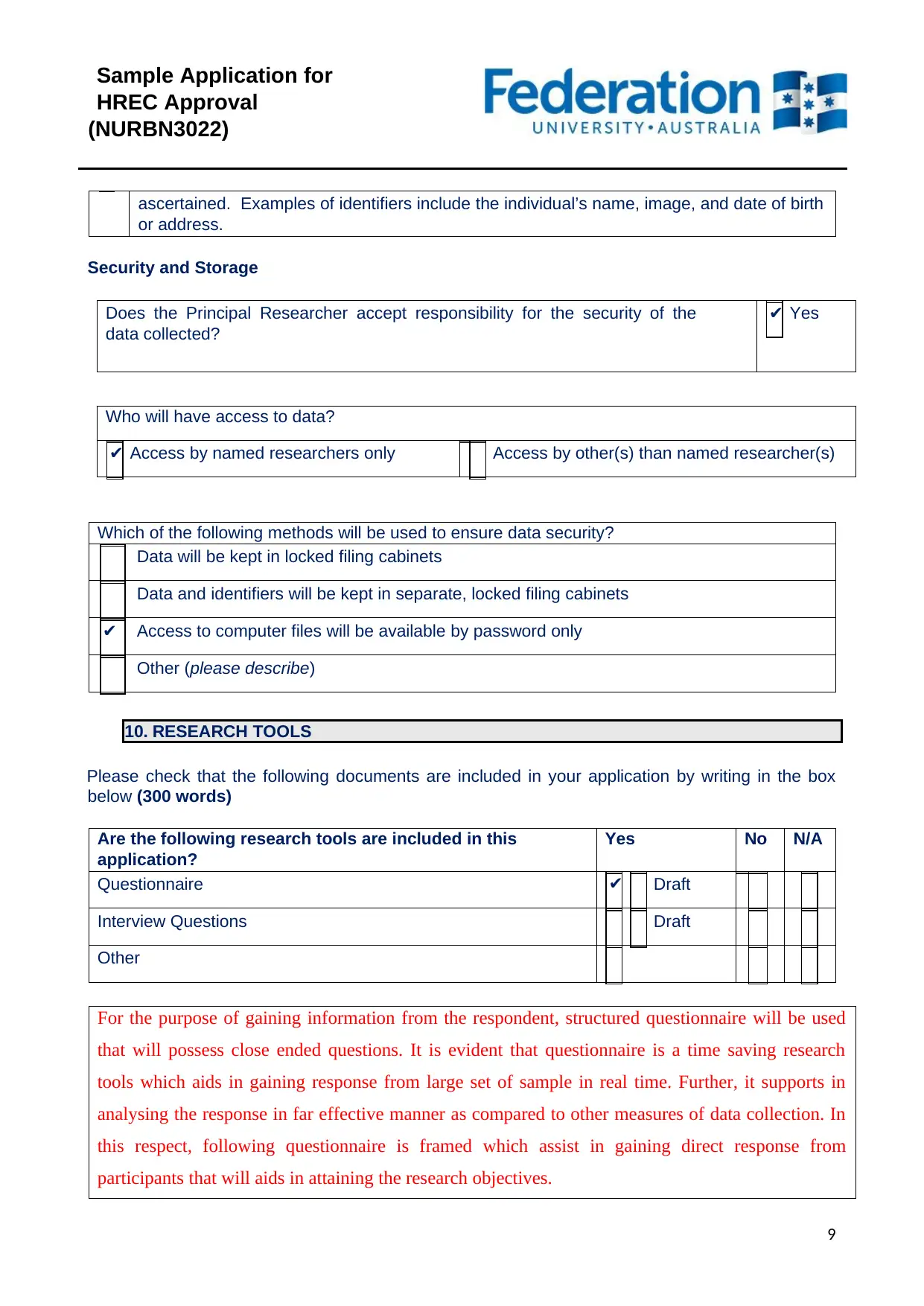
Sample Application for
HREC Approval
(NURBN3022)
ascertained. Examples of identifiers include the individual’s name, image, and date of birth
or address.
Security and Storage
Does the Principal Researcher accept responsibility for the security of the
data collected?
✔ Yes
Who will have access to data?
✔ Access by named researchers only Access by other(s) than named researcher(s)
Which of the following methods will be used to ensure data security?
Data will be kept in locked filing cabinets
Data and identifiers will be kept in separate, locked filing cabinets
✔ Access to computer files will be available by password only
Other (please describe)
10. RESEARCH TOOLS
Please check that the following documents are included in your application by writing in the box
below (300 words)
Are the following research tools are included in this
application?
Yes No N/A
Questionnaire ✔ Draft
Interview Questions Draft
Other
For the purpose of gaining information from the respondent, structured questionnaire will be used
that will possess close ended questions. It is evident that questionnaire is a time saving research
tools which aids in gaining response from large set of sample in real time. Further, it supports in
analysing the response in far effective manner as compared to other measures of data collection. In
this respect, following questionnaire is framed which assist in gaining direct response from
participants that will aids in attaining the research objectives.
9
HREC Approval
(NURBN3022)
ascertained. Examples of identifiers include the individual’s name, image, and date of birth
or address.
Security and Storage
Does the Principal Researcher accept responsibility for the security of the
data collected?
✔ Yes
Who will have access to data?
✔ Access by named researchers only Access by other(s) than named researcher(s)
Which of the following methods will be used to ensure data security?
Data will be kept in locked filing cabinets
Data and identifiers will be kept in separate, locked filing cabinets
✔ Access to computer files will be available by password only
Other (please describe)
10. RESEARCH TOOLS
Please check that the following documents are included in your application by writing in the box
below (300 words)
Are the following research tools are included in this
application?
Yes No N/A
Questionnaire ✔ Draft
Interview Questions Draft
Other
For the purpose of gaining information from the respondent, structured questionnaire will be used
that will possess close ended questions. It is evident that questionnaire is a time saving research
tools which aids in gaining response from large set of sample in real time. Further, it supports in
analysing the response in far effective manner as compared to other measures of data collection. In
this respect, following questionnaire is framed which assist in gaining direct response from
participants that will aids in attaining the research objectives.
9
⊘ This is a preview!⊘
Do you want full access?
Subscribe today to unlock all pages.

Trusted by 1+ million students worldwide
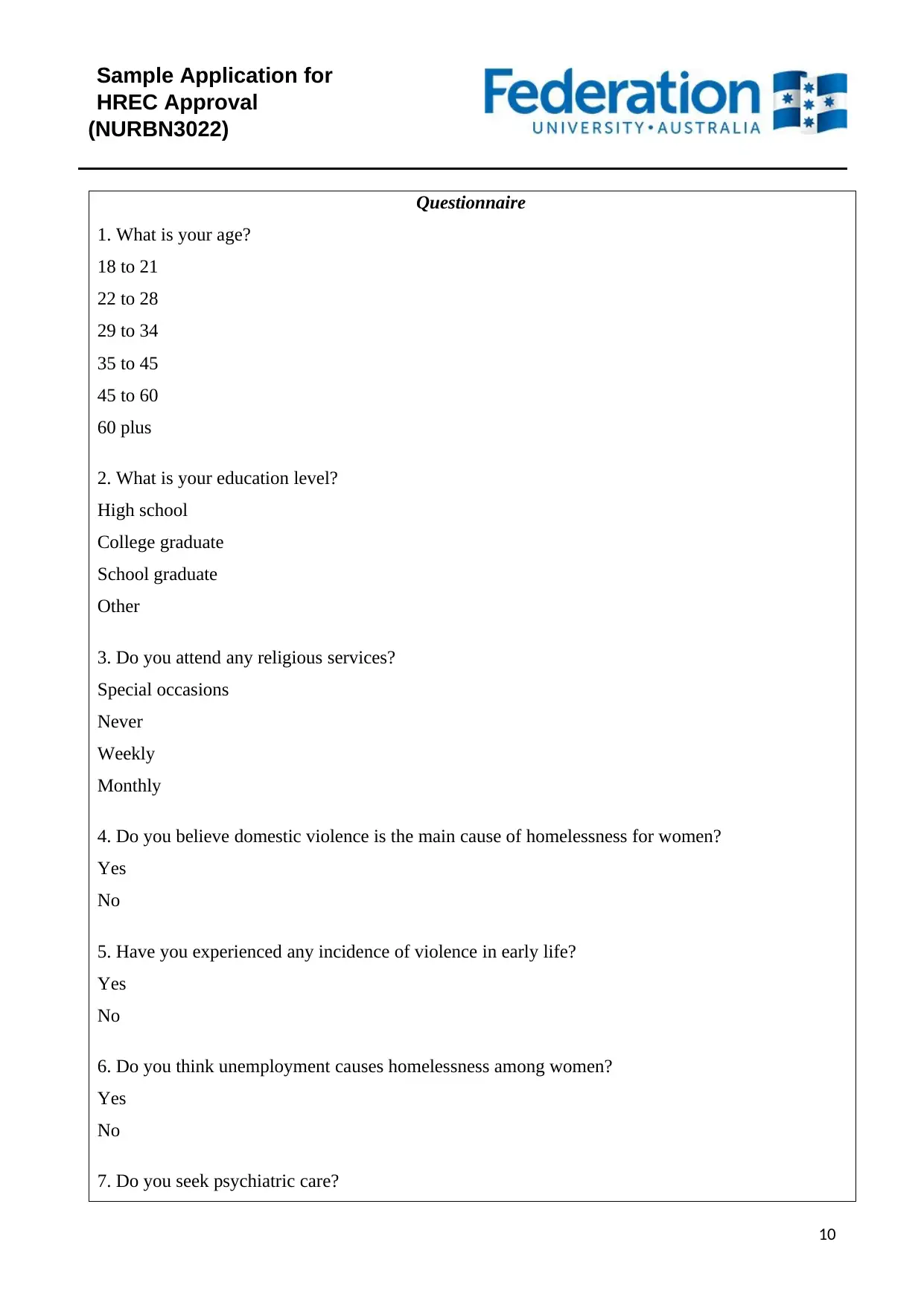
Sample Application for
HREC Approval
(NURBN3022)
Questionnaire
1. What is your age?
18 to 21
22 to 28
29 to 34
35 to 45
45 to 60
60 plus
2. What is your education level?
High school
College graduate
School graduate
Other
3. Do you attend any religious services?
Special occasions
Never
Weekly
Monthly
4. Do you believe domestic violence is the main cause of homelessness for women?
Yes
No
5. Have you experienced any incidence of violence in early life?
Yes
No
6. Do you think unemployment causes homelessness among women?
Yes
No
7. Do you seek psychiatric care?
10
HREC Approval
(NURBN3022)
Questionnaire
1. What is your age?
18 to 21
22 to 28
29 to 34
35 to 45
45 to 60
60 plus
2. What is your education level?
High school
College graduate
School graduate
Other
3. Do you attend any religious services?
Special occasions
Never
Weekly
Monthly
4. Do you believe domestic violence is the main cause of homelessness for women?
Yes
No
5. Have you experienced any incidence of violence in early life?
Yes
No
6. Do you think unemployment causes homelessness among women?
Yes
No
7. Do you seek psychiatric care?
10
Paraphrase This Document
Need a fresh take? Get an instant paraphrase of this document with our AI Paraphraser
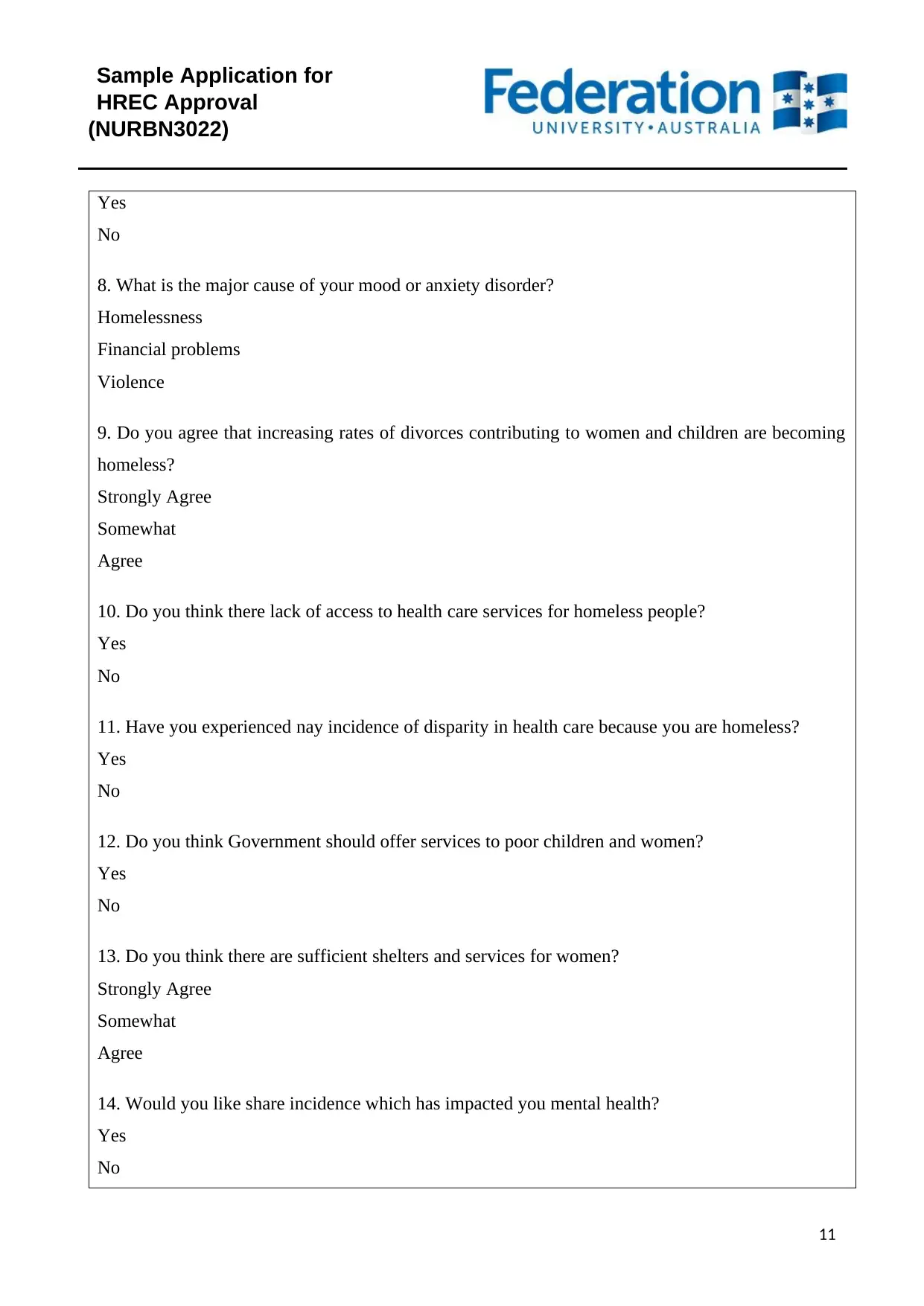
Sample Application for
HREC Approval
(NURBN3022)
Yes
No
8. What is the major cause of your mood or anxiety disorder?
Homelessness
Financial problems
Violence
9. Do you agree that increasing rates of divorces contributing to women and children are becoming
homeless?
Strongly Agree
Somewhat
Agree
10. Do you think there lack of access to health care services for homeless people?
Yes
No
11. Have you experienced nay incidence of disparity in health care because you are homeless?
Yes
No
12. Do you think Government should offer services to poor children and women?
Yes
No
13. Do you think there are sufficient shelters and services for women?
Strongly Agree
Somewhat
Agree
14. Would you like share incidence which has impacted you mental health?
Yes
No
11
HREC Approval
(NURBN3022)
Yes
No
8. What is the major cause of your mood or anxiety disorder?
Homelessness
Financial problems
Violence
9. Do you agree that increasing rates of divorces contributing to women and children are becoming
homeless?
Strongly Agree
Somewhat
Agree
10. Do you think there lack of access to health care services for homeless people?
Yes
No
11. Have you experienced nay incidence of disparity in health care because you are homeless?
Yes
No
12. Do you think Government should offer services to poor children and women?
Yes
No
13. Do you think there are sufficient shelters and services for women?
Strongly Agree
Somewhat
Agree
14. Would you like share incidence which has impacted you mental health?
Yes
No
11
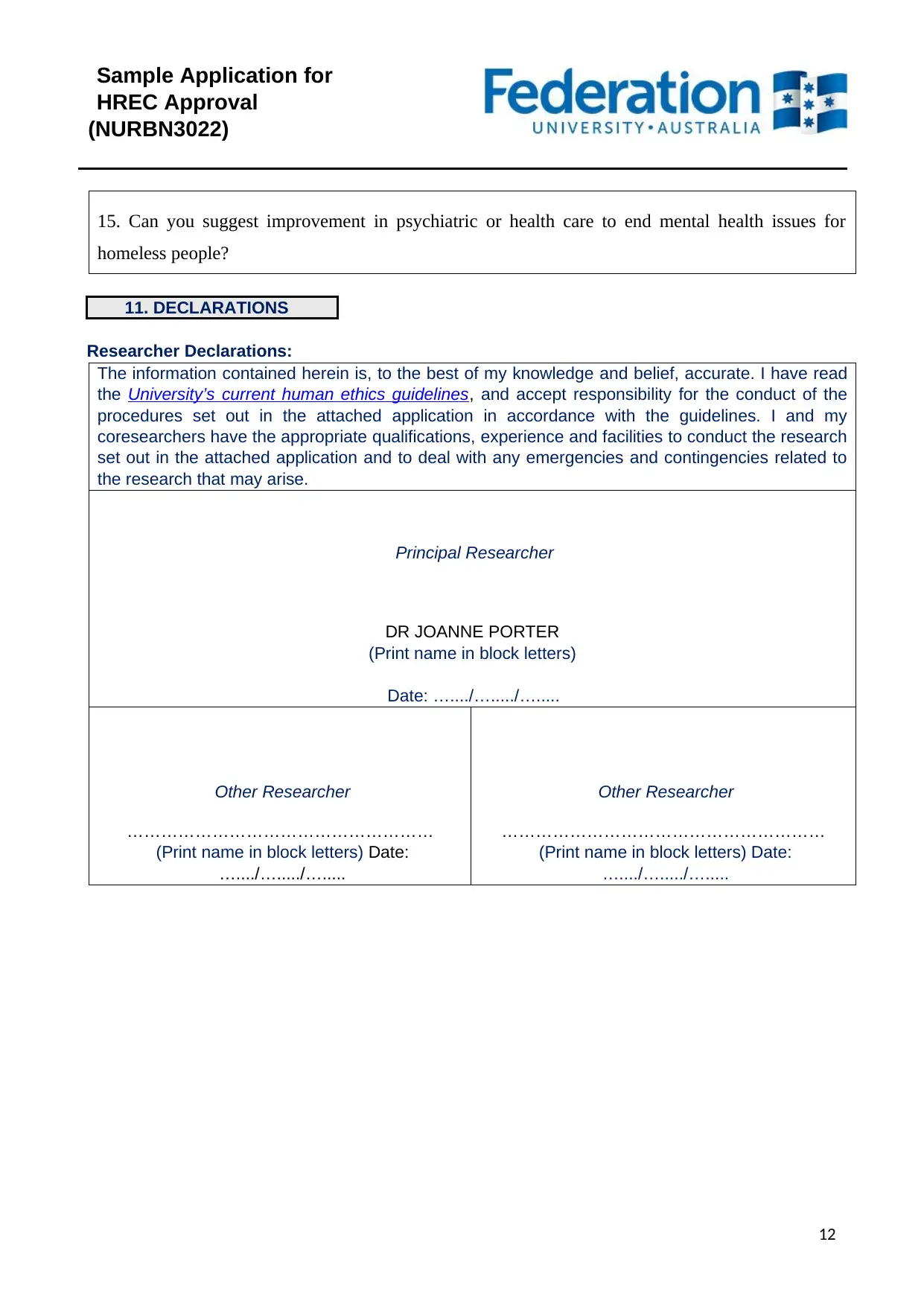
Sample Application for
HREC Approval
(NURBN3022)
15. Can you suggest improvement in psychiatric or health care to end mental health issues for
homeless people?
11. DECLARATIONS
Researcher Declarations:
The information contained herein is, to the best of my knowledge and belief, accurate. I have read
the University’s current human ethics guidelines, and accept responsibility for the conduct of the
procedures set out in the attached application in accordance with the guidelines. I and my
coresearchers have the appropriate qualifications, experience and facilities to conduct the research
set out in the attached application and to deal with any emergencies and contingencies related to
the research that may arise.
Principal Researcher
DR JOANNE PORTER
(Print name in block letters)
Date: …..../…...../….....
Other Researcher
………………………………………………
(Print name in block letters) Date:
…..../…...../….....
Other Researcher
…………………………………………………
(Print name in block letters) Date:
…..../…...../….....
12
HREC Approval
(NURBN3022)
15. Can you suggest improvement in psychiatric or health care to end mental health issues for
homeless people?
11. DECLARATIONS
Researcher Declarations:
The information contained herein is, to the best of my knowledge and belief, accurate. I have read
the University’s current human ethics guidelines, and accept responsibility for the conduct of the
procedures set out in the attached application in accordance with the guidelines. I and my
coresearchers have the appropriate qualifications, experience and facilities to conduct the research
set out in the attached application and to deal with any emergencies and contingencies related to
the research that may arise.
Principal Researcher
DR JOANNE PORTER
(Print name in block letters)
Date: …..../…...../….....
Other Researcher
………………………………………………
(Print name in block letters) Date:
…..../…...../….....
Other Researcher
…………………………………………………
(Print name in block letters) Date:
…..../…...../….....
12
⊘ This is a preview!⊘
Do you want full access?
Subscribe today to unlock all pages.

Trusted by 1+ million students worldwide
1 out of 14
Related Documents
Your All-in-One AI-Powered Toolkit for Academic Success.
+13062052269
info@desklib.com
Available 24*7 on WhatsApp / Email
![[object Object]](/_next/static/media/star-bottom.7253800d.svg)
Unlock your academic potential
Copyright © 2020–2025 A2Z Services. All Rights Reserved. Developed and managed by ZUCOL.





